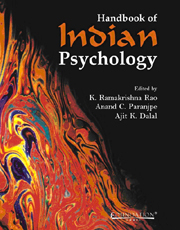Book contents
- Frontmatter
- Contents
- Contributing Authors
- Preface
- 01 Prologue: Introducing Indian Psychology
- 02 Indian Thought and Tradition: A Psychohistorical Perspective
- PART I SYSTEMS AND SCHOOLS
- 03 Jaina Psychology
- 04 The Foundations of Early Buddhist Psychology
- 05 Varieties of Cognition in Early Buddhism
- 06 A Buddhist Theory of Unconscious Mind (Ālaya-Vijñāna)
- 07 Indian Buddhist Theories of Persons
- 08 Buddhist Psychology: A Western Interpretation
- 09 Transpersonal Psychology in the Bhagavad-Gītā: Reflections on Consciousness, Meditation, Work and Love
- 10 Yoga Psychology: Theory and Application
- 11 Patañjali Yoga and Siddhis: Their Relevance to Parapsychological Theory and Research
- 12 Yoga Psychology and the, Sāṃkhyā Metaphysic
- 13 Psychology in the Advaita Vedānta
- 14 The Nyāya-Vaiśeṣika Theory of Perceiving the World of our Experience
- 15 Psychological Theories and Practices in Āyurveda
- PART II TOPICS AND THEMES
- PART III APPLICATIONS AND IMPLICATIONS
- Pronunciation and Transliteration of Sanskrit Alphabet
- Glossary
- Index
10 - Yoga Psychology: Theory and Application
from PART I - SYSTEMS AND SCHOOLS
Published online by Cambridge University Press: 26 October 2011
- Frontmatter
- Contents
- Contributing Authors
- Preface
- 01 Prologue: Introducing Indian Psychology
- 02 Indian Thought and Tradition: A Psychohistorical Perspective
- PART I SYSTEMS AND SCHOOLS
- 03 Jaina Psychology
- 04 The Foundations of Early Buddhist Psychology
- 05 Varieties of Cognition in Early Buddhism
- 06 A Buddhist Theory of Unconscious Mind (Ālaya-Vijñāna)
- 07 Indian Buddhist Theories of Persons
- 08 Buddhist Psychology: A Western Interpretation
- 09 Transpersonal Psychology in the Bhagavad-Gītā: Reflections on Consciousness, Meditation, Work and Love
- 10 Yoga Psychology: Theory and Application
- 11 Patañjali Yoga and Siddhis: Their Relevance to Parapsychological Theory and Research
- 12 Yoga Psychology and the, Sāṃkhyā Metaphysic
- 13 Psychology in the Advaita Vedānta
- 14 The Nyāya-Vaiśeṣika Theory of Perceiving the World of our Experience
- 15 Psychological Theories and Practices in Āyurveda
- PART II TOPICS AND THEMES
- PART III APPLICATIONS AND IMPLICATIONS
- Pronunciation and Transliteration of Sanskrit Alphabet
- Glossary
- Index
Summary
Yoga in its origin is a native Indian psycho-spiritual craft, used for personal transformation and to alleviate suffering in the human condition. In a sense, yoga is pan Indian in that it is not restricted to any particular religion or sect, region or location. While it is central to Brahmanism, Buddhists as well as Jainas have practised some kind of yoga. “Yoga constitutes a characteristic dimension of Indian Thought,” concludes Mircea Eliade (1969) in his influential book Yoga: Immortality and Freedom, “to such a point that wherever Indian religion and culture have made their way, we also find a more or less pure form of yoga” (p.359). There are good reasons to think that yoga is a pre-Aryan native Indian practice(s) that was later assimilated into the Vedic tradition (Narain, 1980). References to yoga practices date back to at least Upaniṣadic times. Explicit mention of yoga occurs in Maitrāyaṇī, Śvetāśvatara and Kaṭtha Upaniṣads among others. Yoga has now acquired pan human relevance going beyond the Indian community. For example, it is today a billion dollar business in the United States of America.
Etymologically, as is well-known, the word “yoga” is derived from the root “yuj,” which means “to bind” or “to yoke”. Inasmuch as there is ambiguity as to what precisely are the things to bind or unify, a wide variety of forms of yoga came into existence. Many of these are unsystematic and some are mystical and esoteric (Eliade, 1969). However, three levels of binding can be discerned from the practices. The first level is connecting the body and the mind.
- Type
- Chapter
- Information
- Handbook of Indian Psychology , pp. 186 - 216Publisher: Foundation BooksPrint publication year: 2008
- 8
- Cited by

